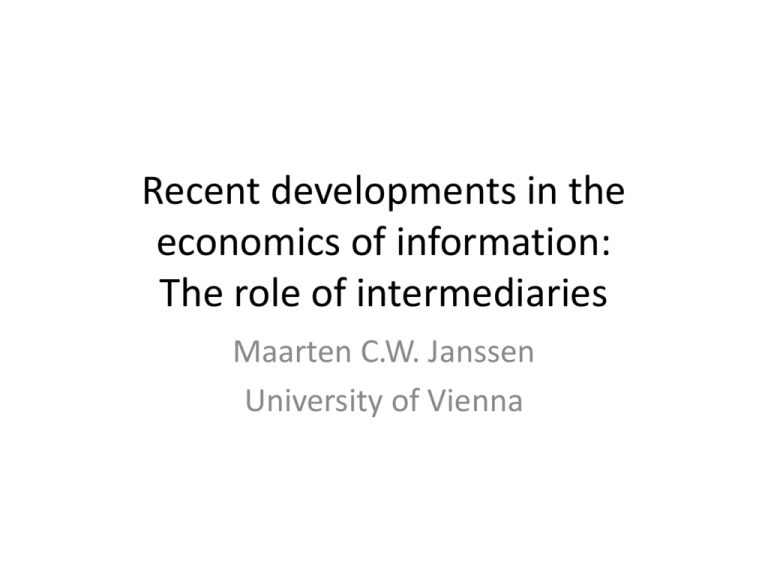Recent developments in the economics of information
advertisement

Recent developments in the economics of information: The role of intermediaries Maarten C.W. Janssen University of Vienna Middlemen (Intermediaries) • General role of Middlemen (Spulber) – Reduce search cost – Reduce other transaction cost – Certify quality (because of increasing returs to scale technology in certification) – Diversify and pool risks – Mitigate adverse selection, moral hazard Focus on Information Revelation • One Role Middleman: check information (quality) a party has, then (partially) reveal it. • Examples: – Laboratory agricultural products – Auditors (financial rating agencies) – Quality schools, hospitals • Main question: how much information should be revealed? What is optimal for the middleman himself? Simple Model Lizzeri (Rand ‘99) • Seller can be of different types t, between a and b • Monopoly intermediary sets a fee P and a disclosure rule D (not knowing quality t) • Knowing P,D and t seller decides whether or not to have quality certified • Upon testing, intermediary gets to know value of t, and discloses according to rule D • Buyers observe P,D and info that is disclosed and bid (against each other) to get commodity. Different disclosure rules • Full disclosure: observe t, reveal t • Interval disclosure (grading, partial pooling)): there are a certain number of pre-determined intervals. If t is observed to be within a certain interval, disclose that interval • Noisy disclosure: observe t, reveal t + ε, where ε is a random variable • Mixtures: For example full disclosure above a certain level, insufficient grade below treshold level Pay-offs, strategies • Seller: pay-off = market price (depending on D) – fee; strategy “have product (not) certified conditional upon P,D and t” • Buyers: pay-off = expected quality (depending on D) - market price if they buy; 0 otherwise; strategy “bid x for product conditional upon P,D whether or not product is tested and test result” • Intermediary: pay-off = P times the probability the seller decides to be certified; strategy “set P and D”. Analysis I • Who has most incentives to have information revealed? (who has least?) – Lowest quality (type) has no incentive to have his type revealed • Can there be an equilibrium with full disclosure (for all t)? – No, lowest type seller is not prepared to pay anything for having quality disclosed; others have. Because intermediary is profit maximizing firm it will charge a positive price- • Closest one can get to full disclosure is that above treshold there is full disclosure, below sellers do not have product certified. – Indifferent type is x(P) such that x(P) – P = E(t given x ≤ x(P) – Figure Analysis II: example • Quality uniformly distributed between 0 and 1. – E(t given x ≤ x(P) = x(P)/2 – x(P) – P =x(P)/2 gives x(P) = 2P • Intermediary max profits P*(1-F(x(P)) = P*(1-2P) – Gives optimal P = ¼, expected profit 1/8 • Sellers below .5 do not have quality certified, tarde at P = 1/4 • Sellers of type t above .5 have quality perfectly certified, trade at price t • Without intermediary price will be ½ (what about adverse selection here?) • Comparison surplus, with and without intermediary (figure) Optimality disclosure rule? • So far, if it perfectly discloses above a certain treshold it is optimal to set P=1/4 • Consider different rule: “everybody who goes passes the test” – What are sellers willing to pay (consider uniform case). If t is lowest certified type, he gets (t+b)/2 – P if he is highest uncertified type he gets (t+a)/2 – If P ≤ (b-a)/2 = (a+b)/2 – a everyone goes to be certified • Surplus sellers equals a – Without certification seller’s surplus depends on expectations (can also be equal to a) – Everyone goes, no disclosure! • If a= 0 and b = 1, – P = ½, profits equal ½ (larger than before), all surplus goes to intermediary without revealing anything! – This is optimal strategy for intermediary! • In general, P = E(t) – a; D is no disclosure; all sellers go to intermediary, sellers make minimum surplus equal to a. Some goods better not to be traded I • Suppose a < 0 <b. • Inefficiencies without intermediary – E(t) < 0, no trade in equilibrium, some trade would be optimal – E(t) > 0, all goods trade in equilibrium, but restricted trade would be optimal • With intermediary – Charge P = E(t given t ≥ 0), disclose that quality is positive (if it really is) – Sellers with positive quality have goods certified – Buyers only buy certified goods. – Sellers do not make profits, intermediary absorbs all surplus – Total surplus is larger than without intermediary Some goods better not to be traded II • Intermediary’s profits (1-F(0))*E(t given t ≥ 0) • Is this rule optimal? (different demarcation criterion x than 0 gives (1-F(x))*E(t given t ≥x). • For uniform distribution: – F(x) = (x-a)/(b-a), E(t given t ≥ x) = (x+b)/2 – Profits intermediary (b2 – x2) / (2(b-a)) – Optimal to choose x=0 – Intermediary chooses welfare optimal fee.




